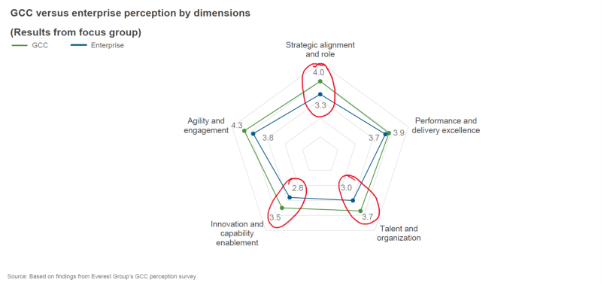Why GBS and GCCs Fail at Proving Their Value, And It’s Not Because the Math Is Hard

Every few weeks, a Global Business Services (GBS) or Global Capability Center (GCC) leader asks me:
“How do we show the value we create, beyond just cost savings?”
It’s a fair question. It’s also the wrong starting point…
Reach out to discuss this topic in depth.
Let me be blunt. The core challenge in value articulation isn’t that quantification is hard, even though yes, it is hard. There are very real constraints to list a few:
-
- Limited visibility into final business outcomes
-
- Patchy data access and siloed systems
-
- Weak correlation between GBS/GCC activity and enterprise Key Performance Indicators (KPIs)
-
- And let’s not forget not everything is measurable in dollar terms
-
- Negligible value linkage to Chief Experience Officer (CXO) metrics
But that’s not why most efforts fail. They fail because the approach is flawed. The mindset is often myopic. And the stakeholder management is, frankly, dysfunctional.
Too often, value quantification becomes an internal project with an external-facing narrative. What should be a cross-enterprise story turns into a GCC/GBS-only initiative, owned by a few individuals chasing metrics while everyone else questions the intent.
We’ve seen enterprise-side stakeholders who get insecure or skeptical, wondering if this is a “credit-stealing” play. We’ve seen sponsors disengage mid-way. We’ve seen leaders confuse value demonstrations with transactional reporting or make this exercise bigger than it needed to be, and losing sight of original objectives. And then we wonder why the exercise backfires.
Everest Group developed industry-first framework for GBS and GCC value quantification more than a decade ago (they were called Global In-House Centers (GICs) back in the day) and has since worked with 60+ GBS/GCCs globally to crack this.
Here’s the truth: the real unlock is not just technical, it’s equally behavioral.
The chart below tells the story, enterprise perception of GCC value consistently trails GCC self-perception across strategic alignment, talent, innovation, and agility. That gap? It’s not about missing dashboards. It’s about missing trust, alignment, and shared understanding.

We’ve developed proprietary frameworks to assign dollar value across savings, risk mitigation, and revenue impact, customized to the GBS/GCC’s role.
But even more critically, we help clients structure the why, what, how, and so what, anchoring it to real stakeholder needs, timing, and trust.
The most mature GBS/GCCs embed value thinking into the business planning cycle, secure upfront sponsorship, distinguish attribution from ownership, and align metrics to CEO priorities, not just service levels.
If your value story is getting ignored, maybe it’s time to ask: Are we solving for the metrics, or are we solving for relevance?
If you want to explore how you should approach your GBS/GCC value quantification and articulation initiatives to expand your GBS/GCCs role in your enterprise’s story – reach out to me ([email protected]) or your Everest Group contact. Let’s talk!
PS: I am joining my friend Rob Bradford from Kimberly Clark to talk about this at Engage Conference Dallas on Sep 10. Learn more about Engage here: https://events.everestgrp.com/engage-dallas2025/agenda